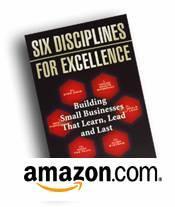It's surprising that in most professions, there are accepted methods and processes for being proficient -- even extremely skilled - or excellent.
Think of what it takes to become an
expert engineer, cabinetmaker, architect, musician, athlete, lawyer or accountant.
It takes years of education, mentoring, coaching and on-the-job training.
Yet - shockingly - for small businesses, there has been really no practical way to learn
how to build an excellent business -- and keep it that way.
That is, until
now.
Unlike most business improvement systems, that describe WHAT the challenges are, or WHY your business needs to continually improve, Six Disciplines shows you HOW to get there.
Six Disciplines incorporates best practices of strategic planning, quality management, business process automation, people performance management and measure-driven improvement in a unique system that is optimized for smaller organizations.
It's a systematic way for the whole organization (not just the leadership team) to learn how to set, and more importantly,
execute strategy.
By following Six Disciplines' repeatable annual, quarterly, weekly and daily cycles (as part of the Business-Building Calendar), team members continually learn and grow at their own pace.
Six Disciplines is a way for everyone in an organization to increase in understanding about about to work on the business, not just in it. And with that realization comes the understanding of the value of having a step-by-step busness improvement method that makes business improvement
last.
